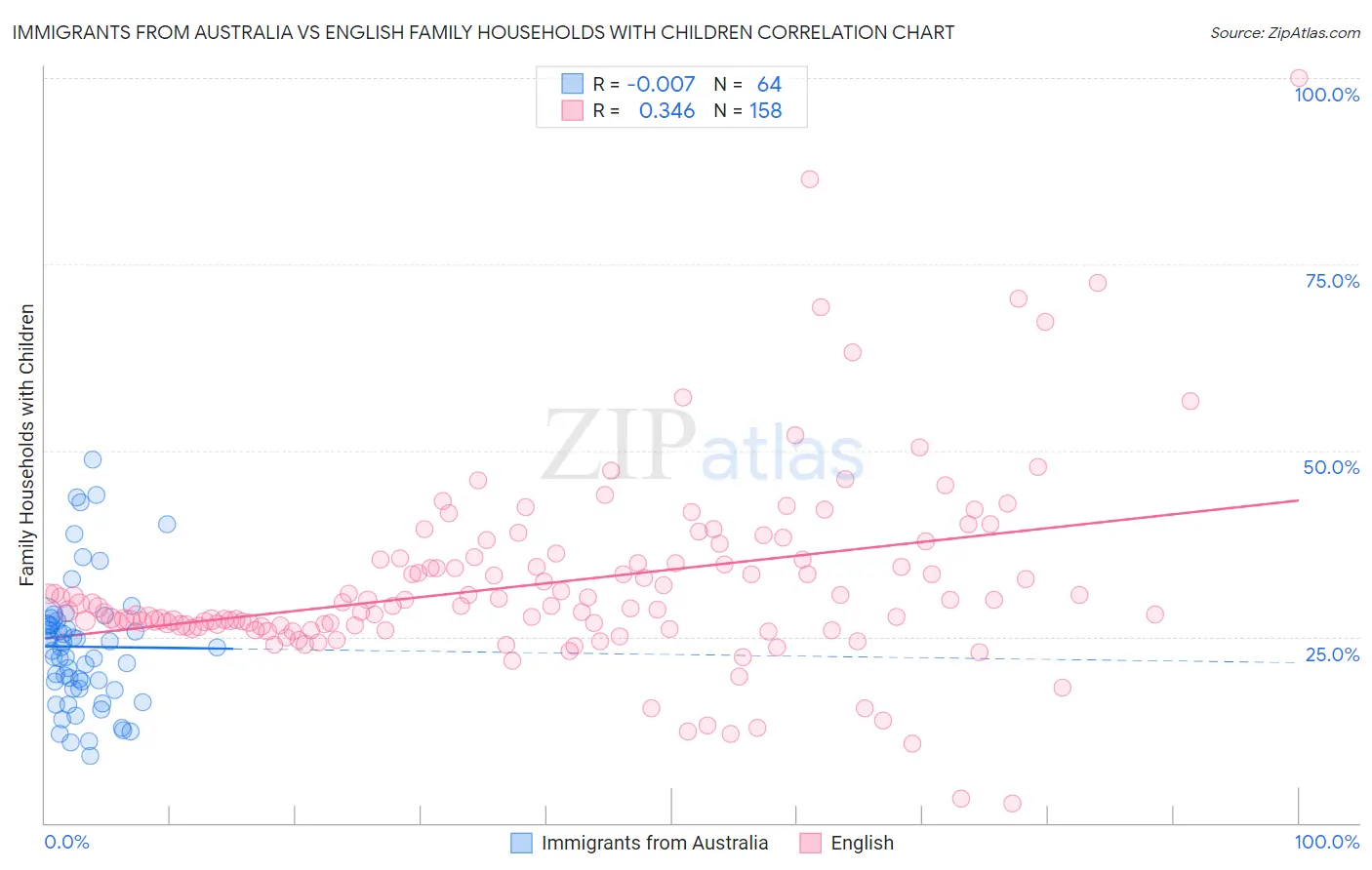Immigrants from Australia vs English Family Households with Children
COMPARE
Immigrants from Australia
English
Family Households with Children
Family Households with Children Comparison
Immigrants from Australia
English
26.0%
FAMILY HOUSEHOLDS WITH CHILDREN
0.0/ 100
METRIC RATING
323rd/ 347
METRIC RANK
27.3%
FAMILY HOUSEHOLDS WITH CHILDREN
32.0/ 100
METRIC RATING
199th/ 347
METRIC RANK
Immigrants from Australia vs English Family Households with Children Correlation Chart
The statistical analysis conducted on geographies consisting of 227,064,474 people shows no correlation between the proportion of Immigrants from Australia and percentage of family households with children in the United States with a correlation coefficient (R) of -0.007 and weighted average of 26.0%. Similarly, the statistical analysis conducted on geographies consisting of 578,706,985 people shows a mild positive correlation between the proportion of English and percentage of family households with children in the United States with a correlation coefficient (R) of 0.346 and weighted average of 27.3%, a difference of 5.1%.

Family Households with Children Correlation Summary
| Measurement | Immigrants from Australia | English |
| Minimum | 9.0% | 2.7% |
| Maximum | 48.8% | 100.0% |
| Range | 39.8% | 97.3% |
| Mean | 23.6% | 32.2% |
| Median | 23.3% | 29.2% |
| Interquartile 25% (IQ1) | 18.0% | 26.5% |
| Interquartile 75% (IQ3) | 26.9% | 35.4% |
| Interquartile Range (IQR) | 8.9% | 8.9% |
| Standard Deviation (Sample) | 8.6% | 12.9% |
| Standard Deviation (Population) | 8.5% | 12.9% |
Similar Demographics by Family Households with Children
Demographics Similar to Immigrants from Australia by Family Households with Children
In terms of family households with children, the demographic groups most similar to Immigrants from Australia are Immigrants from Greece (26.0%, a difference of 0.030%), Chinese (26.0%, a difference of 0.030%), British West Indian (26.0%, a difference of 0.040%), Tlingit-Haida (26.0%, a difference of 0.060%), and Immigrants from France (26.0%, a difference of 0.070%).
| Demographics | Rating | Rank | Family Households with Children |
| Estonians | 0.0 /100 | #316 | Tragic 26.1% |
| Ottawa | 0.0 /100 | #317 | Tragic 26.1% |
| Iroquois | 0.0 /100 | #318 | Tragic 26.1% |
| Immigrants | France | 0.0 /100 | #319 | Tragic 26.0% |
| Tlingit-Haida | 0.0 /100 | #320 | Tragic 26.0% |
| British West Indians | 0.0 /100 | #321 | Tragic 26.0% |
| Immigrants | Greece | 0.0 /100 | #322 | Tragic 26.0% |
| Immigrants | Australia | 0.0 /100 | #323 | Tragic 26.0% |
| Chinese | 0.0 /100 | #324 | Tragic 26.0% |
| Barbadians | 0.0 /100 | #325 | Tragic 26.0% |
| Immigrants | Ireland | 0.0 /100 | #326 | Tragic 26.0% |
| Immigrants | Barbados | 0.0 /100 | #327 | Tragic 26.0% |
| Immigrants | Albania | 0.0 /100 | #328 | Tragic 25.9% |
| Cypriots | 0.0 /100 | #329 | Tragic 25.9% |
| Immigrants | Latvia | 0.0 /100 | #330 | Tragic 25.9% |
Demographics Similar to English by Family Households with Children
In terms of family households with children, the demographic groups most similar to English are Immigrants from Romania (27.4%, a difference of 0.060%), Norwegian (27.4%, a difference of 0.070%), Cheyenne (27.4%, a difference of 0.080%), Crow (27.4%, a difference of 0.090%), and Immigrants from Congo (27.3%, a difference of 0.090%).
| Demographics | Rating | Rank | Family Households with Children |
| Pennsylvania Germans | 37.5 /100 | #192 | Fair 27.4% |
| Swedes | 36.9 /100 | #193 | Fair 27.4% |
| Immigrants | Iran | 36.1 /100 | #194 | Fair 27.4% |
| Crow | 35.7 /100 | #195 | Fair 27.4% |
| Cheyenne | 35.1 /100 | #196 | Fair 27.4% |
| Norwegians | 35.0 /100 | #197 | Fair 27.4% |
| Immigrants | Romania | 34.4 /100 | #198 | Fair 27.4% |
| English | 32.0 /100 | #199 | Fair 27.3% |
| Immigrants | Congo | 28.7 /100 | #200 | Fair 27.3% |
| Bhutanese | 25.1 /100 | #201 | Fair 27.3% |
| Americans | 22.8 /100 | #202 | Fair 27.3% |
| Kiowa | 22.2 /100 | #203 | Fair 27.3% |
| Immigrants | Sudan | 21.6 /100 | #204 | Fair 27.3% |
| Immigrants | Haiti | 20.3 /100 | #205 | Fair 27.2% |
| Immigrants | Micronesia | 20.2 /100 | #206 | Fair 27.2% |